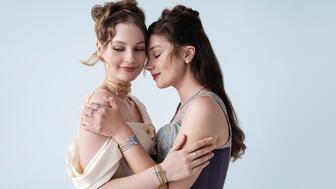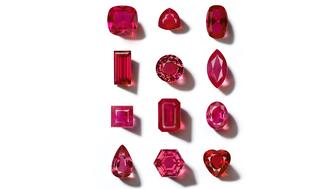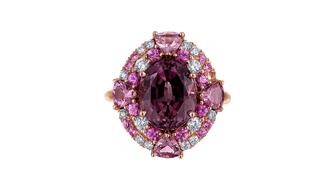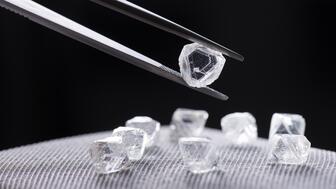What to Know About Consumers in 2023
From dwindling savings to the growing resale market, here’s what National Retail Federation experts want retailers to know about shoppers.

And yet, it’s been a good few years for retailers, especially jewelry retailers, as shoppers continue to spend.
Whether or not the good times will keep rolling was a hot topic at the National Retail Federation’s Retail’s Big Show conference, held last month in New York City.
A panel of experts from NRF and consumer purchase data platform Affinity Solutions held a press-only discussion to share their insights on the year ahead.
Here are the six biggest takeaways.
Consumer spending is shifting away from goods to services, but goods spending is still increasing.
At the start of the pandemic, when COVID-19 restrictions prevented shoppers from spending on services, more money was spent on goods.
The increased spending on goods was also a result of government stimulus programs, said Mark Mathews, vice president of research development and industry analysis at NRF.
“What we saw during the pandemic was a demand phenomenon. I know that there are other narratives out there that talk about supply chain challenges, but really, the government pumped $10 trillion into our economy via fiscal and monetary policy, and so consumers have been spending.”
Mathews defended the often-maligned supply chain, stating that it actually performed “heroically” considering how difficult it is for retailers to ramp up to meet fast-growing demand.
At the start of the pandemic, consumers spent around 31 percent of their expenditures on goods, he said, but that increased to 36 percent.
“That doesn’t sound like a big number, but that’s $600 billion a year,” said Mathews.
As restrictions have lifted, spending has shifted toward services, bringing the percentage of expenditures on goods closer to 34 percent, but that doesn’t necessarily mean consumers are spending less on goods.
“We’ve seen a shrink in the share of goods [as a percentage of expenditures], but the pie has grown,” explained Mathews.
“So actually, instead of taking away from spending on goods to spend on services, the consumer has decided to spend on [both]. While the share has shrunk, the actual amount spent on goods has been increasing the entire time.”
To continue to spend in both categories, many consumers have been relying on their savings and accruing debt.
Shoppers have been dipping into excess savings, but they may soon dry up.
The government stimulus program allowed many people to save money because their disposable income exceeded their expenditures.
The savings rate spiked to 34 percent during the pandemic, an “unheard of” rate, said Mathews, leaving consumers with $2 trillion in excess savings.
The wealth of disposable income allowed shoppers to spend, shelling out more than $1 trillion in savings in the last 18 months, but inflation is driving up prices and quickly eating into those excess funds.
“There’s still $1 trillion left of excess savings, but we’re burning through that at a pretty high rate,” said Mathews. “We’re going to get to a point in 2023 where, if inflation remains high, you are going to potentially see consumers running into a wall because they won’t be able to maintain that level of spending.”
Mathews estimated if spending continues at this rate, it will take a year to 18 months for these savings to dry up.
To stimulate the economy, Mathews advocated for pushing money toward lower-income households, like the stimulus program did, because that money tends to be spent rather than saved and goes right back into the economy.
Panelist Jonathan Silver, CEO of Affinity Solutions, echoed a similar sentiment. His company’s data was used by the U.S. government to determine the cut-off for round three of the stimulus checks.
Those under the $78,000 income level, defined by Silver as lower-income households, “spent it very quickly and that stimulated the economy that clearly needed it. It really does make a difference, putting money in the hands of low-income folks.”
As prices rise and savings dwindle, that raises concern about increasing debt levels.
“For those lower-income households, if wages aren’t keeping pace with inflation, where do they fund that from? Potentially debt, but that’s concerning because interest rates are rising,” said Mathews.
Consumer debt has increased by $200 billion over the last two years, he added.
Shoppers are looking for a bargain, giving resale an opening.
As savings wane and prices spike, consumers are on the lookout for deals and discounts.
Moderator Katherine Cullen, NRF’s senior director of industry and consumer insights, talked about how this is playing out in the retail space.
“We are seeing a return to a value-focused shopper across income groups, but that will play out differently for different income segments,” she said.
Though higher-income households tend to be the most worried about inflation, she said they tend to change their behavior the least because of their access to savings, which may not be an option for lower-income houses.
Shoppers may gravitate to off-price or discounted products, while others will turn to the resale market, particularly Gen Z shoppers.
While there are third-party resale sites, like Depop and TheRealReal, Cullen noted she’s seeing a lot of retailers introduce their own resale and recycling platforms, like H&M and Zara.
“To me, that signals that this is an underlying trend that will be around for a while, but rather than fighting it, retailers are participating in it and starting to build it into their business, so I think that’s something to watch going forward.”
Don’t presume all pre-pandemic behaviors will make a comeback.
“Just assuming that behavior will return to normal for the sake of it, I think is a dangerous thing,” said Mathews.
“There are some behaviors that we developed during the pandemic, like streaming as opposed to going to movie theaters, [that] could stick around a little bit longer than we expect and that’s going to be something that we’re watching very closely as we move forward.”
For example, Mathews noted when restaurants shut down, more people began to cook for themselves. They honed their cooking skills, made healthier food, and saved money in the process, so they may not be running back to restaurants at the pre-pandemic rate.
The pandemic also spurred on technological advancements, particularly in retail, turning features like online shopping, Buy Online Pick-up In Store, and curbside pick-up into mainstays.
NRF’s Cullen noted, “Even as we’re seeing renewed engagement around stores, the pressure on stores to be convenient, to be engaging, is certainly much higher because people have gotten used to online shopping.”
“These shifts will impact what the store looks like and how retailers adapt to this environment moving forward.”
As consumer behavior changes, economic indicators aren’t what they used to be.
Despite everything the last few years have thrown at consumers, they just keep spending.
If prices are rising and savings are falling, consumers should be spending less money and feeling less confident about the economy, but that hasn’t always been the case.
The disconnect left the panelists wondering if the tried-and-true economic indicators, like consumer confidence and the Consumer Price Index, are the best ways to predict consumer behavior.
“Everyone in the room tends to look at consumer confidence and consumer sentiment, but it’s not the leading indicator that it used to be,” said Silver.
“It used to be that there was a high correlation [between consumer confidence and spending],” he said. “People are getting signals that make them feel bad but they still want to take out their wallet and spend.”
That’s not the only disconnect between data and consumer behavior.
“You would expect that an increase in purchases of essentials should result in a decrease of purchases in discretionary and that’s not what we’re seeing. We’re seeing both grow pretty significantly,” said Silver.
Mathews talked about The Consumer Price Index, which has been used as a measure of inflation.
CPI measures the average change in prices over time consumers will pay for a basket of goods and services.
Since inflation hits individuals differently, it may not be the best measurement, said Mathews.
“Many times, we have people look at retail sales and say, well it grew 7 percent but CPI [inflation] is at 8 percent, so you’re not really growing. You can’t look at it that way,” he said.
What many people don’t realize, he said, is that one-third of CPI’s measurement accounts for shelter, which has been driving prices much higher.
“For the last three months, goods have been in deflation,” he said.
The outlook for the year is still promising.
Mathews and Silver had a fairly positive outlook on the year ahead, with a few conditions.
As for where consumer spending will land, that will come down to inflation compared to wage increase, said Silver.
Mathews said, “The saving grace here is if we see inflation easing and we see wages continue to be strong, then that gives you a little bit of a buffer to continue to spend. If we continue to see negative real wages, then that’s going to be a problem. We’re talking about sometime in the next year to 18 months or so, it all becomes unstable.”
Silver took a more conservative position, stating, “We’re bullish going into the first half of ‘23 and then we’ll see beyond that. But we also think that what [retailers] do is going to have a big impact on how the consumer behaves.”
Mathews noted how encouraged he was by the resilience of both the retail industry and consumers during the pandemic.
“It leaves me feeling bullish because I know as we look ahead there are going to be some economic challenges. But we’ve been through those, so that gives me hope that as we move forward, we can overcome [them],” he said.
The Latest

“Bridgerton” actresses Hannah Dodd and Claudia Jessie star in the brand’s “Rules to Love By” campaign.

Founded by jeweler and sculptor Ana Khouri, the brand is “expanding the boundaries of what high jewelry can be.”

The jewelry manufacturer and supplier is going with a fiery shade it says symbolizes power and transformation.

How Jewelers of America’s 20 Under 40 are leading to ensure a brighter future for the jewelry industry.

The singer-songwriter will make her debut as the French luxury brand’s new ambassador in a campaign for its “Coco Crush” jewelry line.


The nonprofit’s new president and CEO, Annie Doresca, also began her role this month.

As the shopping mall model evolves and online retail grows, Smith shares his predictions for the future of physical stores.

Roseco’s 704-page catalog showcases new lab-grown diamonds, findings, tools & more—available in print or interactive digital editions.

The trade show is slated for Jan. 31-Feb. 2 at The Lighthouse in New York City's Chelsea neighborhood.

January’s birthstone comes in a rainbow of colors, from the traditional red to orange, purple, and green.

The annual report highlights how it supported communities in areas where natural diamonds are mined, crafted, and sold.

Footage of a fight breaking out in the NYC Diamond District was viewed millions of times on Instagram and Facebook.

The supplier has a curated list of must-have tools for jewelers doing in-house custom work this year.

The Signet Jewelers-owned store, which turned 100 last year, calls its new concept stores “The Edit.”

Linda Coutu is rejoining the precious metals provider as its director of sales.

The governing board welcomed two new members, Claire Scragg and Susan Eisen.

Sparkle with festive diamond jewelry as we celebrate the beginning of 2026.

The master jeweler, Olympian, former senator, and Korean War veteran founded the brand Nighthorse Jewelry.

In its annual report, Pinterest noted an increase in searches for brooches, heirloom jewelry, and ‘80s luxury.

Executive Chairman Richard Baker will take over the role as rumors swirl that a bankruptcy filing is imminent for the troubled retailer.

Mohr had just retired in June after more than two decades as Couture’s retailer liaison.

Shekhar Shah of Real Gems Inc. will serve as president of the Indian Diamond & Colorstone Association in 2026.

This year’s good luck charm features the mythical horse Pegasus, and is our first Piece of the Week of the new year.

Articles about crime, engagement rings, and a necklace worn in the World Series generated the most interest among readers.

As part of the leadership transition, Sherry Smith will take on the role of vice president of coaching strategy and development.

It marks the third time the country has headed the Kimberley Process. Ghana will serve as vice chair.

The new Bulova x Stetson designs highlight two animals often associated with the American West—the bison and the Texas Longhorn.



























